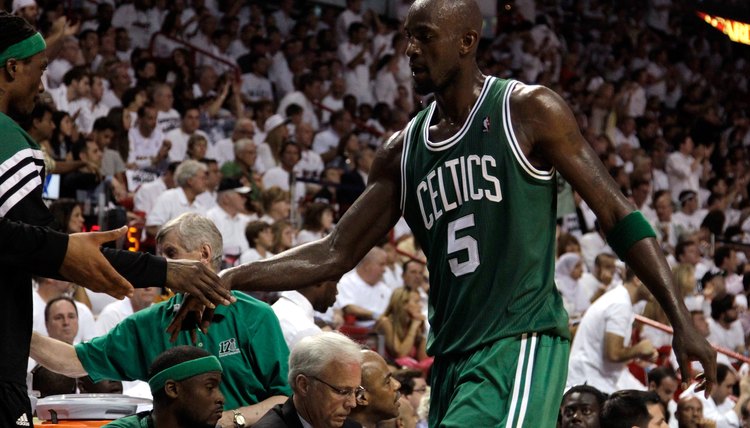What Is a Hip Check in Basketball?

Anyone who has played in a game of competitive hoops knows that the concept of basketball as a noncontact sport is pure myth. Basketball players constantly bump, collide and push against one another to attain better rebounding, defensive and offensive positioning. While referees usually cite players for blatantly hitting an opponent with an arm or leg, illegally striking an opponent with the force of the hips is much harder to detect.
Definition
A hip check is a blow dealt by striking the opponent with a hip thrust to his hips or lower abdominal region, disrupting momentum and path of travel. Rule 12B, section I-a of the National Basketball Association rule book specifies that hip checking is an illegal offense since it is "contact that results in the re-routing of an opponent." When a referee sees a player perform a hip check, play immediately stops and the referee assesses a personal foul.
Screening Hip Check
Setting a pick or screen is a fundamental basketball tactic in which you help a teammate get away from his defender by placing yourself in the defender's path. A player who sets a pick will often subtly -- or less than subtly -- move toward the impeded defender while he runs by. Kevin Garnett is one NBA player renowned for throwing hip checks while setting screens, but even a master like Garnett occasionally pays the price when caught. In Game 7 of the 2012 NBA Eastern Conference Finals, Garnett picked up two quick fouls for hip checks early in the second quarter. Garnett's replacements struggled as he languished on the bench with foul trouble, and Boston eventually lost a close contest to the Miami Heat.
Charging Hip Check
A second common basketball situation in which a hip check occurs is when a running offensive player collides with a stationary defender who is standing perpendicular to his direction of travel. Such a collision between an out-of-control offensive player and a nonmoving defender is referred to as a charging violation. When a referee observes the collision, the player who delivered the hip check receives a personal foul and possession of the ball goes to the other team.
Flagrant Hip Check
A hip check that a referee deems to be delivered recklessly or with intent to injure the opponent can result in assessment of a flagrant foul, the most severe citation a player can receive. The offending player receives a personal foul, and the fouled player shoots two free throws plus his team retains possession of the ball. If the officials deem a flagrant hip check to be particularly unnecessary or dangerous, the player who fouled is ejected.
Hip Check Injuries
A hard hip check to a running player can cause a fall and result in injuries including bruises, strains, concussions or broken limbs. Even more mundane hip checks are potentially dangerous, as a solid blow to the hip area may cause a contusion on the pelvic or hip bone. These injuries, which are referred to as hip pointers, are common in basketball and can put a player on crutches for a few days or weeks. In extreme cases a blow to the hip can result in hip or pelvic fracture and necessitate a longer rehabilitation period.
References
Resources
Writer Bio
Dan Howard is a sports and fitness aficionado who holds a master's degree in psychology. Howard's postgraduate research on the brain and learning has appeared in several academic books and peer-reviewed psychology journals.
